
94% of researchers rate our articles as excellent or good
Learn more about the work of our research integrity team to safeguard the quality of each article we publish.
Find out more
ORIGINAL RESEARCH article
Front. Earth Sci., 04 February 2022
Sec. Geochemistry
Volume 10 - 2022 | https://doi.org/10.3389/feart.2022.823308
This article is part of the Research TopicIsotopic Geochemistry of Natural GasView all 14 articles
 Quanyou Liu1,2*
Quanyou Liu1,2* Xiaoqi Wu1,3
Xiaoqi Wu1,3 Huichong Jia4
Huichong Jia4 Chunhua Ni1,3
Chunhua Ni1,3 Jianhui Zhu1,3
Jianhui Zhu1,3 Jiujun Miao1,3
Jiujun Miao1,3 Dongya Zhu1,2
Dongya Zhu1,2 Qingqiang Meng1,2
Qingqiang Meng1,2 Weilong Peng1,2
Weilong Peng1,2 Huiyuan Xu1,2
Huiyuan Xu1,2Helium-bearing gas is accumulated in the Lower Ordovician, Upper Carboniferous, and Lower Permian reservoirs of the Daniudi gas field in Ordos Basin, and the helium concentrations and isotopic compositions are investigated in order to reveal the abundance and origin of helium. Geochemical characteristics indicate that the natural gas from the Daniudi gas field has helium concentrations of 0.0271–0.1273%, with R/Ra ratios of 0.007–0.072. The 4He/20Ne ratios range from 848 to 17,000, which are substantially higher than the ratio of air or air saturated water. The proved helium reserves of the Daniudi gas field exceed 100 × 106 m3, suggesting an extra-large helium gas field. Helium in the field is of crustal origin and derived from the radioactive decay of U and Th in the rocks and minerals, with no significant contribution by atmospheric or mantle-derived helium. The natural gas in the Daniudi gas field displays the characteristics of typical crustal helium, which is consistent with the gases from cratonic basins (Ordos, Sichuan, and Tarim) in China, whereas the gases from rift basins (Songliao, Bohai Bay, and Subei) have experienced a significant addition of mantle-derived helium.
Helium (He) is an exhaustible natural resource with strategic values, and its unique physiochemical property leads it to an irreplaceable role in high-tech fields (Xu et al., 1998; Anderson, 2018). The development of science and technology made the application fields of helium become more and more extensive, causing the global demand of helium gas to increase annually by 4–6% (Zhao et al., 2012), and thus the shortage of helium supply existed for a long time. The leading locations for estimated helium resources in the world are the United States, Qatar, Algeria, and Russia, and their helium resources account for >90% of the world’s total amount (Anderson, 2018). Helium resources in China are rare, with the supply basically relying on imports, and they have been poorly studied and explored to date. Therefore, the amounts of helium resources and reserves urgently need to be further evaluated (Tao et al., 2019; Chen et al., 2021).
Helium in natural gas has three different sources, including (1) atmospheric helium—being the helium in the air with a concentration of 5.24 × 10–6, it was mainly produced from volcanic eruption, magma degassing, and rock weathering (Porcelli et al., 2002; Wang et al., 2020; Chen et al., 2021); (2) crustal helium—which is being generated by the radioactive decay of uranium (U) and thorium (Th) in crustal rocks and minerals (Oxburgh et al., 1986; Xu et al., 1998; Porcelli et al., 2002), and the production of crustal helium depends on the U and Th concentrations as well as the history of the rocks and minerals (Chen et al., 2021); and (3) mantle-derived helium—which is from mantle-derived volatiles and released into the sedimentary strata through magmatism and fault activities (O’Nions and Oxburgh, 1983; Poreda et al., 1986; Poreda et al., 1988; Xu et al., 1997; Anderson, 2000).
Helium commonly has two isotopes, i.e., 3He and 4He, and the isotopic compositions of helium from different sources have certain differences. The 3He/4He ratio of air (Ra) is 1.4 × 10–6 (Mamyrin et al., 1970), whereas the ratios of crustal and mantle-derived helium are 2 × 10–8 and 1.1 × 10–5, respectively (Lupton, 1983; Xu, 1996). The R/Ra ratios (R refers to the 3He/4He ratio of the samples) were commonly used to characterize helium isotopic compositions (Xu et al., 1995a; Ni et al., 2014), and they have played an important role in revealing mantle-derived magmatism (Sano et al., 1984; Poreda et al., 1988; Marty et al., 1989) and tectonic background (Xu et al., 1995a; Xu, 1997; Polyak et al., 2000; Ding et al., 2005) and tracing the origin and source of fluids in the petroleum system (Xu et al., 1995b; Dai et al., 2008; Ni et al., 2014; Dai et al., 2017; Zhang et al., 2019; Cao et al., 2020).
The only profitable way to produce helium at present is to extract from helium-bearing natural gas (Anderson, 2018; Tao et al., 2019), and the helium in natural gas pools is mainly crustal and mantle-derived (Xu et al., 1995a; Chen et al., 2021). Ordos Basin is a crucial petroliferous basin in China with an annual gas production of 46.496 × 109 m3 in 2018, and it becomes the first Chinese basin with an annual gas production of over 40 × 109 m3 (Dai et al., 2019). Helium-bearing gas with He% ≥0.05%, having potential industrial helium values, has been confirmed in the Sulige gas field in the basin (Dai et al., 2017). The Daniudi gas field is located in northern Ordos Basin with the proved gas reserves of 454.563 × 109 m3 (Yang and Liu, 2014). Previous studies on the natural gas of the Daniudi gas field principally focused on genetic types and filling patterns (Liu et al., 2015; Wu et al., 2017a; Wu et al., 2017b), and less attention has been paid to helium. Therefore, the geochemical characteristics of helium for the Daniudi gas field were studied in this work based on the concentrations and isotopic compositions of helium and its relationship with neon and argon isotopes as well as the relationship with CH4 and CO2 contents. The abundance and origin of helium were further investigated, which would provide scientific proofs for revealing helium enrichment mechanisms and evaluating the resource potential of helium.
Ordos Basin, a multicycle cratonic basin in central China (Figure 1A), tectonically belongs to the western margin of the North China Block, and it is the second largest sedimentary basin in China, covering an area of 37 × 104 km2 (Yang and Pei, 1996). The basin is commonly divided into six secondary structural units (Yang et al., 2005), i.e., Weibei Uplift, Yishan Slope, Yimeng Uplift, Tianhuan Depression, West Margin Thrust Belt, and Jinxi Fault–Fold Belt (Figure 1B). The exploration fields of conventional natural gas in Ordos Basin mainly include the Upper Paleozoic Carboniferous–Permian and Lower Paleozoic Ordovician strata. The natural gas of the discovered large gas fields is accumulated in the Carboniferous–Permian tight sandstone reservoirs in majority, except that the gas from the Jingbian gas field is mainly reservoired in marine carbonate rocks in the Lower Ordovician Majiagou Formation (Dai et al., 2005a; Liu et al., 2009; Liu et al., 2015; Dai, 2016).
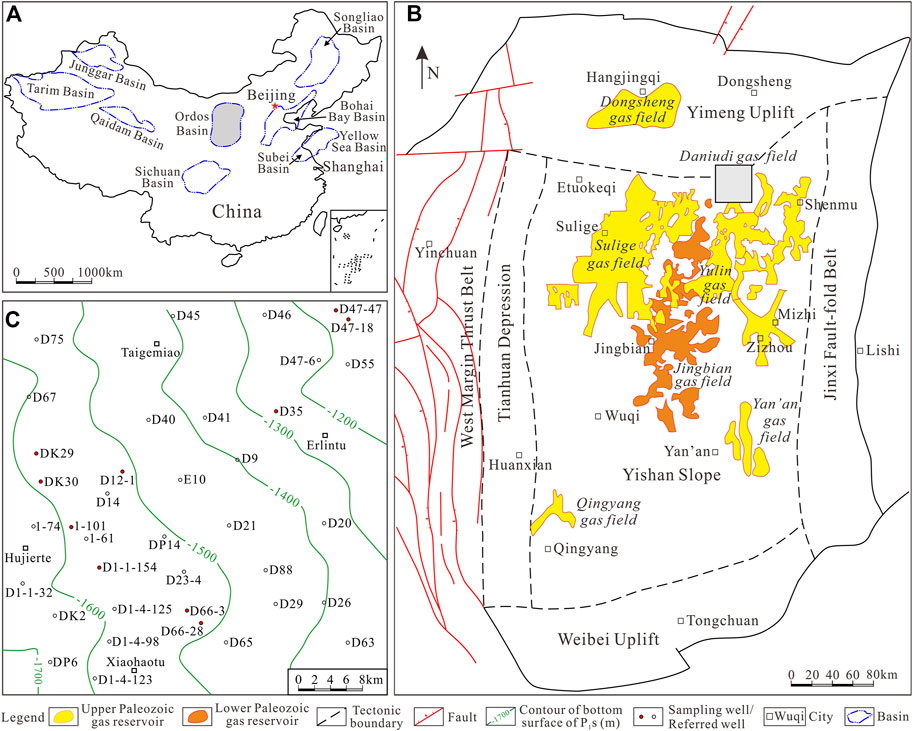
FIGURE 1. The location of Ordos Basin in China (A), location of the Daniudi gas field in the basin (B), and distribution of gas wells in the gas field (C).
The Daniudi gas field is located in the north margin of the Yishan Slope (Figure 1B), covering an area of 2,003.71 km2 (Dai, 2016), and the strata dip gently to the southwest (Figure 1C). Natural gas in the field is mainly accumulated in the Upper Paleozoic tight sandstone reservoirs in the Carboniferous Taiyuan (C3t), Lower Permian Shanxi (P1s), and Lower Shihezi (P1x) formations, and natural gas has also been discovered in carbonate reservoirs in the Lower Ordovician Majiagou Formation (O1m) (Figure 2). The Upper Paleozoic (C3t, P1s, and P1x) gas is mainly coal-derived gas and sourced from the C3t-P1s coal measures, and the regional caprocks of the gas pools are the stably distributed lacustrine mudstone and silty mudstone in the Upper Shihezi Formation (P2s) (Liu et al., 2015; Wu et al., 2017a). However, the Lower Paleozoic (O1m) gas is mixed by the Upper Paleozoic coal-derived gas and oil-associated gas from the O1m source rocks (Wu et al., 2017b; Liu et al., 2015), and the main caprocks of the gas pools are the mudstone and iron–aluminum mudstone in the Benxi Formation (C2b) (Figure 2).
In this study, 20 gas samples from the O1m, C3t, P1s, and P1x reservoirs in the Daniudi gas field were collected directly from well heads. Double-ended stainless steel cylinders (5-cm radius, ∼ 7,000-cm3 volume) were used to collect the gas samples, and air contamination was removed by flushing the lines first for 15–20 min. The chemical composition of the main components and the stable carbon isotopic data for alkane gas were available from Liu et al. (2015) and Wu et al. (2017a). Noble gas concentrations and isotopic ratios were measured using a Noblesse SFT noble gas mass spectrometer at the Key Laboratory of Petroleum Resources Research, Chinese Academy of Sciences, in Lanzhou.
The gas was purified using a spongy titanium furnace at 800°C to remove active gases (C1–C4, N2, CO2, etc.) and then separated at a temperature ranging from 8 to 100 K using a cryogenic trap filled with activated charcoal. Noble gases were adsorbed in the trap at 8 K for 20 min, and He, Ne, and Ar gases were released for analysis at the temperature of 15, 50, and 100 K, respectively. 4He isotope was analyzed using a Faraday collector, and 3He was analyzed using an electric multiple detector. 20Ne isotope was analyzed using a Faraday collector. 40Ar and 36Ar isotopes were analyzed using a Faraday cup. The volume of He, Ne, and Ar, respectively, was determined for the calibration of their concentration. The detailed analytical procedure can be seen in Cao et al. (2018).
The authors have also collected noble gas data from the Sichuan (Fan, 1999; Wu et al., 2013; Ni et al., 2014; Dai et al., 2017), Bohai Bay (Dai et al., 2005b; Zhang et al., 2008), Songliao (Liu et al., 2016), Subei (Xu et al., 1997; Liu et al., 2017), Tarim (Liu et al., 2018), and Ordos (Dai et al., 2017) basins for comparative analysis.
The He, Ne, and Ar concentrations and isotopic ratios of natural gas from the Daniudi gas field in Ordos Basin are listed in Table 1.
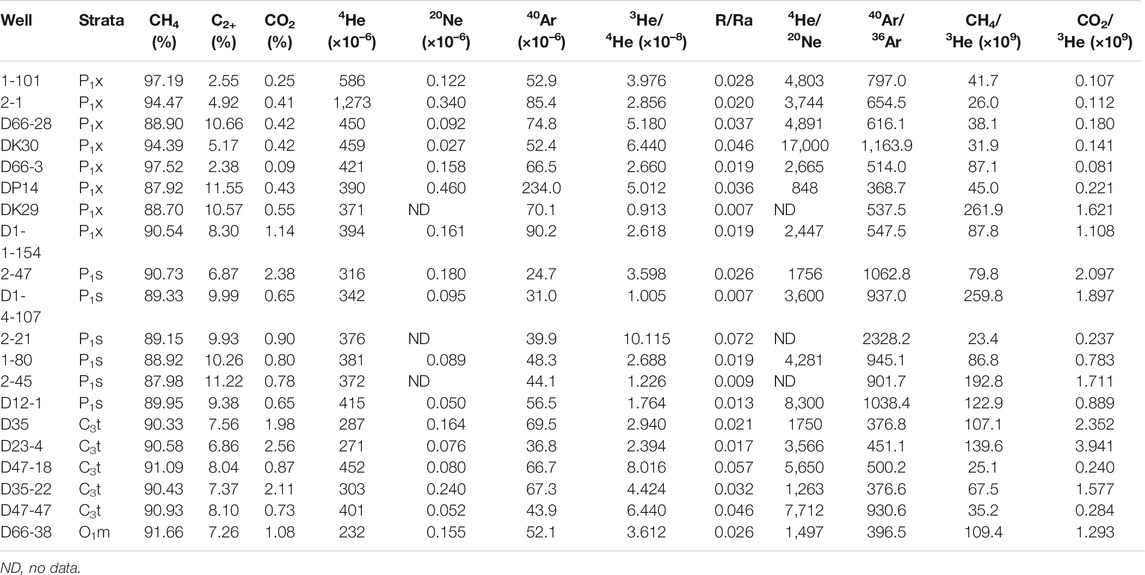
TABLE 1. Noble gas concentrations and isotopic compositions of natural gas in the Daniudi gas field, Ordos Basin.
The helium concentrations of natural gas from the Upper Paleozoic C3t, P1s, and P1x reservoirs of the Daniudi gas field are in the ranges of 0.0271–0.0452, 0.0316–0.0415, and 0.0371–0.1273%, respectively, with the corresponding average values of 0.034% (N = 5), 0.0367% (N = 6), and 0.054% (N = 8) (Table 1; Figure 3A). One gas sample (Well D66-38) from the Lower Paleozoic O1m reservoir displays a lower helium concentration of 0.0232% (Table 1; Figure 3A).
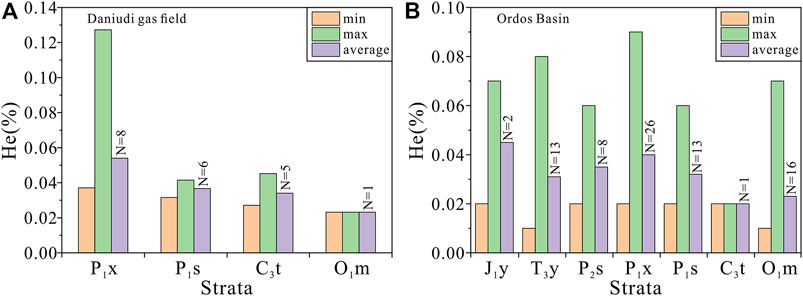
FIGURE 3. Distribution of helium concentrations in natural gas from different strata in the Daniudi gas field (A) and Ordos Basin (B). The data in (B) are from Dai et al. (2017).
The 3He/4He ratio of air (Ra) is generally considered as 1.4 × 10–6 (Mamyrin et al., 1970), whereas the 3He/4He ratios (R) of natural gas in the Daniudi gas field are in the range of (0.9128–10.115) × 10–8, and thus the calculated R/Ra ratios of the gas range from 0.007 to 0.072 (Table 1). The R/Ra ratios of the C3t, P1s, and P1x gases are in the ranges of 0.017–0.057, 0.007–0.072, and 0.007–0.046, with average values of 0.035, 0.024, and 0.026, respectively (Table 1). The O1m gas sample has a R/Ra ratio of 0.026 (Table 1).
The 4He/20Ne ratios of the C3t, P1s, and P1x gases from the Daniudi gas field are in the ranges of 1,263–7,712, 1,756–8,300, and 848–17,000, respectively, and the corresponding 40Ar/36Ar ratios are in the ranges of 376.6–930.6, 901.7–2,328.2, and 368.7–1,163.9, respectively (Table 1). The O1m gas sample has 4He/20Ne and 40Ar/36Ar ratios of 1,499 and 396.5, respectively (Table 1).
The CH4/3He ratios of the P1x, P1s, and C3t gases from the Daniudi gas field are in the ranges of (26.0–261.9) × 109, (23.4–259.8) × 109, and (25.1–139.6) × 109, respectively, with corresponding average values of 77.4 × 109 (N = 8), 127.6 × 109 (N = 6), and 74.9 × 109 (N = 5) (Table 1). The CO2/3He ratios of these gases are in the ranges of (0.081–1.621) × 109, (0.237–2.097) × 109, and (0.240–3.941) × 109, respectively, with corresponding average values of 0.446 × 109, 1.269 × 109, and 1.679 × 109 (Table 1). The O1m gas sample has CH4/3He and CO2/3He ratios of 109.4 × 109 and 1.293 × 109, respectively (Table 1).
Dai et al. (2017) have classified helium-bearing gas into five categories based on helium concentration, i.e., helium extremely depleted (He% <0.005%), helium depleted (0.005% ≤He% <0.050%), helium general (0.050% ≤He% <0.150%), helium rich (0.150% ≤He% <0.500%), and helium extremely rich (He% ≥0.500%) gases. The natural gas from the Panhandle–Hugoton field in the US is helium-rich gas with an average helium concentration of 0.586% (Brown, 2019), and the gas from the Weiyuan gas field in Sichuan Basin in China is also helium-rich gas with an average helium concentration of 0.251% for 215 gas samples (Dai et al., 2017).
The natural gas in Ordos Basin is mainly accumulated in the P1x, P1s, C3t, and O1m reservoirs, and the statistics conducted by Dai et al. (2017) indicate that the average helium concentrations are 0.04, 0.032, 0.02, and 0.023%, respectively (Figure 3B). The gas is mainly helium-depleted gas with 0.005% ≤He% <0.050%, except for a small amount of gas samples being general gas with 0.050% ≤He% <0.150%. The helium concentrations of 20 gas samples from the Daniudi gas field are in the range of 0.0271–0.1273% (Table 1), in which 18 gas samples are helium depleted (0.005% ≤He% <0.050%), and the other two samples from the P1x reservoirs (wells 1-101 and 2-1) are helium general (0.050% ≤He% <0.150%). The average helium concentration (0.0425%; Table 1) is consistent with the standard of helium-depleted gas, with no samples being helium rich or extremely rich.
According to the helium amount in the proved gas reserves, the helium-bearing gas fields can be classified into very small, small, medium, large, and extra-large gas fields, with helium reserves of <5 × 106 m3, (5–25) × 106 m3, (25–50) × 106 m3, (50–100) × 106 m3, and ≥100 × 106 m3, respectively (Dai et al., 2017). The helium reserves of the Panhandle–Hugoton field in the US were 18 × 109 m3 at the time of discovery (Brown, 2019), and the proved helium reserves of the Weiyuan gas field in Sichuan Basin and the Hetianhe gas field in Tarim Basin in China are 80 × 106 and 195.91 × 106 m3, respectively (Tao et al., 2019), which imply that these three fields meet the standard of an extra-large helium gas field. The proved gas reserves of the Daniudi gas field are 454.563 × 109 m3 (Yang and Liu, 2014), and the proved helium reserves are calculated as 193.19 × 106 m3 according to the average helium concentration of 0.0425% (Table 1), which also meet the standard of an extra-large helium gas field.
The only profitable way to produce helium is believed to be by extracting from helium-bearing natural gas, and it was previously considered that helium concentrations were required to reach 0.1% (Tao et al., 2019; Chen et al., 2021). Helium was profitably produced as a byproduct of liquefied natural gas in Qatar, and the economically required helium concentrations can be as low as 0.04% (Anderson, 2018). The average helium concentration in natural gas from the Daniudi gas field is 0.0425% (Table 1), which meets the commercial requirement of helium production through the above-mentioned mechanism.
Helium in natural gas has three sources, and the typical 3He/4He ratios of atmospheric, crustal, and mantle-derived helium are 1.4 × 10–6 (Mamyrin et al., 1970), 2 × 10–8, and 1.1 × 10–5 (Lupton, 1983; Xu, 1996), respectively. The calculated typical R/Ra ratios for crustal and mantle-derived helium are 0.014 and 7.9, respectively. Helium isotopic compositions have been widely used to trace the mantle-derived volatiles (Wakita and Sano, 1983; Oxburgh et al., 1986; Poreda et al., 1988; Xu et al., 1997). It is commonly considered that R/Ra >1 suggests the input of considerable mantle-derived helium, whereas R/Ra ≤0.1 implies typical crustal helium (Xu et al., 1998; Li et al., 2017; Chen et al., 2021).
The study on helium isotopic compositions of natural gas in Chinese sedimentary basins indicated that the distribution pattern of 3He/4He ratios was controlled by the tectonic environment (Xu et al., 1995a). Both the Ordos and Sichuan basins belong to the central tectonic domain in China, with almost pure crustal helium (Xu et al., 1995a). Helium gas from the Sinian to Jurassic reservoirs in Sichuan Basin is of typical crustal origin (Ni et al., 2014). The R/Ra ratios of 113 gas samples from the basin are in the range of 0.002–0.05, with an average of 0.015, and a correlation between the R/Ra ratios and He concentrations is not observed (Wang et al., 2020).
The 93 gas samples from the Lower Ordovician Majiagou to Lower Jurassic Yan’an formations in Ordos Basin have R/Ra ratios of 0.0148–0.0974, with an average of 0.0334 (Dai et al., 2017). The R/Ra ratios for the Daniudi gas field range from 0.007 to 0.072 (Table 1), which are consistent with those for other areas of Ordos Basin (Figure 4). The R/Ra ratios for the different gas fields, including the Daniudi gas field, in the basin are lower than 0.1 (Figure 4), suggesting typical crustal origin with few mantle-derived helium, and the R/Ra ratios and He concentrations display few correlations (Figure 5). Therefore, helium in natural gas from the Daniudi gas field is supposed to be derived from the radioactive decay of U and Th in the rocks and minerals. Since the rocks and minerals in different strata, including P1x, P1s, and C3t, contain various contents of U and Th, the radioactive decay of these U and Th could generate different concentrations of helium, and the generated helium could mix and accumulate in the reservoirs. Moreover, it is much easier for helium to migrate than alkane gas due to its smaller molecular. Therefore, it seems impossible to figure out where and which strata the rocks and minerals are from. Ordos Basin is a cratonic basin (Xu et al., 1995a; Dai et al., 2017) characterized by gentle structure and stable subsidence with a few faults or magmatism (Wu et al., 2017a). Natural gas from cratonic basins (e.g., Sichuan, Ordos) in China has significantly lower R/Ra ratios than that from rift basins (e.g., Bohai Bay) (Figure 5), indicating a few inputs of mantle-derived helium in the cratonic basins (Dai et al., 2017).
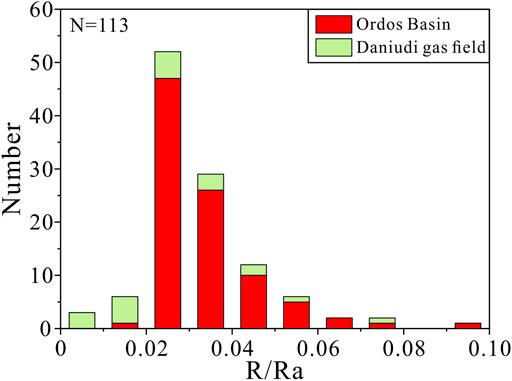
FIGURE 4. Distribution of the R/Ra ratios of natural gas in Ordos Basin (Dai et al., 2017) and the Daniudi gas field.
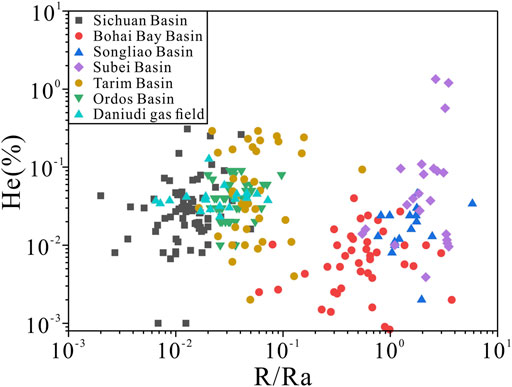
FIGURE 5. Correlation of He (%) versus R/Ra of natural gas in the Daniudi gas field and typical petroliferous basins in China.
The He concentrations and R/Ra ratios of natural gas from different petroliferous basins in China are uncorrelated (Figure 5). The natural gas from Bohai Bay Basin has been contributed by a small amount of mantle-derived components, with R/Ra ratios and He concentrations commonly higher than 0.1 and lower than 0.1%, respectively (Figure 5). Although gases from the Subei and Songliao basins display a substantial contribution of mantle-derived helium with R/Ra ≥0.5, the He concentrations are generally lower than 0.1 (Figure 5). The natural gases from the Sichuan, Ordos, and Tarim basins are mainly of crustal origin, with R/Ra <0.1, and the He concentrations are principally lower than 0.1%, suggesting few differences with those for the Subei and Songliao basins (Figure 5). Therefore, the contribution of mantle-derived helium does not necessarily lead to the increase of He concentrations (Figure 5).
The natural gases from the Sinian and pre-Sinian strata in southern Sichuan Basin have high helium abundance compared to those from the other areas of the basin, suggesting an increase of crustal helium with time (Ni et al., 2014). However, the helium abundance of natural gas from different strata of the Daniudi gas field and other areas of Ordos Basin displays a few increase with time (Figure 3B), which indicates a little accumulation effect of crustal helium with time.
Li et al. (2017) have proposed a diagram of 3He/4He versus 40Ar/36Ar to identify gases of crustal and mantle origins, which determines different participation degrees of mantle-derived components according to the 3He/4He ratios (Figure 6). The natural gas from Subei Basin generally has a higher 3He/4He ratio than the air, i.e., R/Ra >1, suggesting the mixed crust–mantle origin with considerable mantle helium (Figure 6). The natural gases from Bohai Bay Basin are mainly of crust origin assisted by mantle origin with R/Ra >0.1, and some of the gases are of mixed crust–mantle origin (with considerable mantle origin) with R/Ra >1 (Figure 6). The 40Ar/36Ar ratios for the Daniudi gas field in Ordos Basin range from 368.7 to 2,328.2 with R/Ra <0.1 (Table 1), suggesting a typical crust origin, and the 3He/4He and 40Ar/36Ar ratios are uncorrelated (Figure 6).
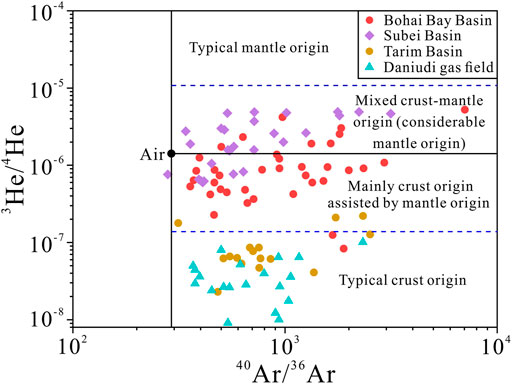
FIGURE 6. Correlation of 3He/4He vs. 40Ar/36Ar of natural gas in the Daniudi gas field and typical petroliferous basins in China [modified after Li et al. (2017)].
The 4He/20Ne ratios of natural gas from the Daniudi gas field range from 848 to 17,000 (Table 1), which are substantially higher than the ratio of air (0.318; Sano et al., 2013) or air-saturated water (ASW) (0.288, Kipfer et al., 2002). Therefore, atmospheric or ASW-derived helium has little contribution to natural gas in the field. The proportion of mantle-derived helium in the gas is less than 1% as indicated in the correlation diagram between R/Ra and 4He/20Ne ratios, which suggests the typical characteristics of crustal noble gas (Figure 7). Zhang et al. (2019) have used noble gases to trace ground water evolution and assessed helium accumulation in Weihe Basin in China, which provides an example for us to study the role of water in the migration of helium. It is a pity that we have not conducted such studies in the Daniudi gas field, and the present work only focused on the geochemical characteristics of helium in natural gas.
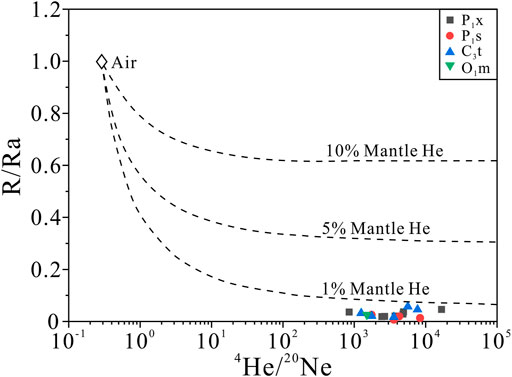
FIGURE 7. Correlation of R/Ra versus 4He/20Ne of natural gas in the Daniudi gas field [modified after Zhang et al. (2019)].
The CH4 content of natural gas from the Daniudi gas field is in the range of 87.98–97.52%, with an average of 91.04%, whereas the CO2 content is in the range of 0.09–11.22%, with an average of 0.96% (Table 1). Both the CH4 and CO2 contents have an insignificant correlation with the R/Ra ratios (Figures 8A,B), indicating that the origins of CH4 and CO2 are uncorrelated with the origin of He. Helium in natural gas from the Daniudi gas field is of crustal origin (Figure 6, Figure 7) and derived from the radioactive decay of U and Th in crustal rocks and minerals. The genetic identification of natural gas indicates that alkane gases, including CH4, in the field are thermogenic and sourced from the direct or indirect thermal cracking of organic matters (Liu et al., 2015; Wu et al., 2017a; Wu et al., 2017b). CO2 in natural gas from the Chinese cratonic basins (Sichuan and Ordos) commonly has contents lower than 5% (Figure 8B) and associated with the hydrocarbon generation process and decomposition of carbonates (Dai et al., 2017). However, natural gas from the rift basins (Bohai Bay, Subei, and Songliao) may have higher CO2 contents of up to 100% (Figure 8B), and this CO2 is of magmatic or mantle-derived origin (Dai et al., 2017). Therefore, the CO2 contents and R/Ra ratios of natural gas from Chinese sedimentary basins generally have few correlations due to the different origins of CO2 and He, except that only a few gas samples from rift basins (Bohai Bay, Subei, and Songliao) with both high CO2 contents and R/Ra ratios were directly from magmatism or mantle degassing (Figure 8B).
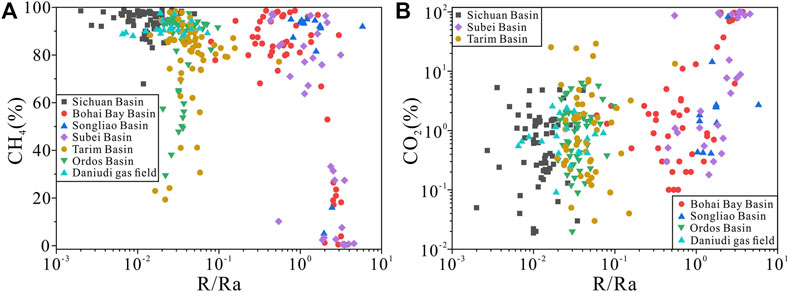
FIGURE 8. Cross-plots of CH4 (%) (A) and CO2 (%) (B) vs. R/Ra of natural gas in the Daniudi gas field and typical petroliferous basins in China.
The cross-plot of CH4/3He versus R/Ra is conducive to constrain the possible crustal and magmatic source of natural gas (Poreda et al., 1986; Jenden et al., 1993; Ni et al., 2014; Dai et al., 2017). Ni et al. (2014) and Dai et al. (2017) have demonstrated that most gases from cratonic basins (Ordos, Sichuan, and Tarim) in China have CH4/3He ratios mainly between 109 and 1012, with R/Ra <0.1, suggesting a typical crustal origin, whereas the gases from rift basins (Bohai Bay, Songliao, and Subei) commonly display CH4/3He ratios between 106 and 1011, with R/Ra >0.1, indicating the incorporation of magmatic components (Figure 9A). The CH4/3He ratios of natural gas from the Daniudi gas field are in the range of (23.4–261.9) × 109 (Table 1), which are consistent with those from other areas of Ordos Basin (Figure 9A).

FIGURE 9. Cross-plots of CH4/3He versus R/Ra (A) and CO2/3He versus R/Ra (B) of natural gas in the Daniudi gas field and typical petroliferous basins in China. Crustal end-member, magmatic end-member, and the mixing line in Figure 1 are from Jenden et al. (1993), and the mixing line in Figure 1 is from Poreda et al. (1988).
The CO2/3He ratios of natural gas from magmatic systems are within a narrow range (109–1010) compared with those of crustal fluids (105–1013) (Ballentine et al., 2000). In the plot of CO2/3He versus R/Ra, natural gas from active continental margins was explained by a two-component mixing between a crustal high-CO2/3He, low-R/Ra end-member and a magmatic low-CO2/3He, high-R/Ra end-member (Poreda et al., 1988). The varying CO2/3He (3.0 × 107–1.3 × 1010) and low R/Ra (0.002–0.035) ratios of natural gas from eastern Sichuan Basin suggest a typical crustal origin (Wu et al., 2013). The CO2/3He ratios of natural gas from the Daniudi gas field range from 0.081 × 109 to 3.941 × 109, with R/Ra <0.1 (Table 1), which are consistent with those from other areas in Ordos Basin (Figure 9B). The natural gases from cratonic basins (Ordos, Sichuan, and Tarim) in China display crustal characteristics of both CO2/3He and R/Ra ratios, whereas those from rift basins (Songliao, Bohai Bay, and Subei) display the contribution of magmatic end-member (Figure 9B).
Moreover, it is noteworthy that the CH4/3He ratio does not necessarily mean that the hydrocarbon gas is organic or inorganic since the CH4 and He might be derived from the crust and the mantle, respectively (Dai et al., 2017). The CO2/3He ratio may display similar features. Therefore, great attention has to be paid to only use these two parameters, and the identification of natural gas origin needs to be conducted based on comprehensive analyses of more parameters.
Helium is considered as an exhaustible natural resource with strategic values, and the replaceable role and wide application of helium determine that helium gas exploration needs more input and investment. The relevant studies on helium in natural gas in China mainly focused on the helium contents and isotopic compositions. However, the migration and accumulation mechanisms are weakly studied. The understandings of both origin and source of helium will be conducive to reveal the migration pathways and accumulation model. To accelerate the studies on the enrichment mechanisms of helium is an effective approach to find more helium resources.
The helium concentrations of natural gas from the Daniudi gas field in Ordos Basin are in the range of 0.0271–0.1273%, with an average helium concentration of 0.0425%. The 3He/4He ratios of the gas are in the range of (0.9128–10.115) × 10–8, and the calculated R/Ra ratios range from 0.007 to 0.072. The 4He/20Ne ratios are in the range of 848–17,000, with the 40Ar/36Ar ratios ranging from 368.7 to 2,328.2. The CH4/3He and CO2/3He ratios of the gas are in the ranges of (23.4–261.9) × 109 and (0.081–3.941) × 109, respectively.
The Daniudi gas field is an extra-large helium gas field with proved helium reserves of over 100 × 106 m3. Helium from the different strata of the field is of crustal origin, with R/Ra <0.1, and it is supposed to be derived from the radioactive decay of U and Th in the rocks and minerals, with little contribution by atmospheric or mantle-derived helium. The natural gases from cratonic basins (Ordos, Sichuan, and Tarim) in China display crustal helium characteristics, whereas those from rift basins (Songliao, Bohai Bay, and Subei) display the contribution of mantle-derived helium.
The original contributions presented in the study are included in the article/supplementary material. Further inquiries can be directed to the corresponding author.
QL contributed to conceptualization, data curation, and writing. XW contributed to data curation and writing. HJ contributed to conceptualization. CN contributed to data curation and methodology. JZ contributed to methodology and investigation. JM contributed to investigation. DZ contributed to methodology. QM contributed to investigation. WP contributed to data curation. HX contributed to investigation.
This work was funded by the National Natural Science Foundation of China (grant nos.: U20B6001, 42141021, 42172149, and 41872122) and the Strategic Priority Research Program of the Chinese Academy of Sciences (Class A) (grant nos. XDA14010402 and XDA14010404).
QL, XW, HJ, CN, JZ, JM, DZ, QM, WP, and HX were employed by the company SINOPEC.
All claims expressed in this article are solely those of the authors and do not necessarily represent those of their affiliated organizations or those of the publisher, the editors, and the reviewers. Any product that may be evaluated in this article or claim that may be made by its manufacturer is not guaranteed or endorsed by the publisher.
The authors appreciate Prof. Jinxing Dai, academician of the Chinese Academy of Sciences, for the long-standing guidance on the relevant studies. The SINOPEC North China Branch Company is acknowledged for the assistance on sample collection.
Anderson, D. L. (2000). The Statistics and Distribution of Helium in the Mantle. Int. Geol. Rev. 42, 289–311. doi:10.1080/00206810009465084
Anderson, S. T. (2018). Economics, Helium, and the U.S. Federal Helium Reserve: Summary and Outlook. Nat. Resour. Res. 27, 455–477. doi:10.1007/s11053-017-9359-y
Ballentine, C. J., Schoell, M., Coleman, D., and Cain, B. A. (2000). Magmatic CO2 in Natural Gases in the Permian Basin, West Texas: Identifying the Regional Source and Filling History. J. Geochem. Explor. 69-70, 59–63. doi:10.1016/s0375-6742(00)00045-5
Brown, A. (2019). Origin of Helium and Nitrogen in the Panhandle-Hugoton Field of Texas, Oklahoma, and Kansas, United States. AAPG Bull. 103 (2), 369–403. doi:10.1306/07111817343
Cao, C., Zhang, M., Tang, Q., Yang, Y., Lv, Z., Zhang, T., et al. (2018). Noble Gas Isotopic Variations and Geological Implication of Longmaxi Shale Gas in Sichuan Basin, China. Mar. Pet. Geol. 89, 38–46. doi:10.1016/j.marpetgeo.2017.01.022
Cao, C., Zhang, M., Li, L., Wang, Y., Li, Z., Du, L., et al. (2020). Tracing the Sources and Evolution Processes of Shale Gas by Coupling Stable (C, H) and noble Gas Isotopic Compositions: Cases from Weiyuan and Changning in Sichuan Basin, China. J. Nat. Gas Sci. Eng. 78, 103304. doi:10.1016/j.jngse.2020.103304
Chen, J., Liu, K., Dong, Q., Wang, H., Luo, B., and Dai, X. (2021). Research Status of Helium Resources in Natural Gas and Prospects of Helium Resources in China. Nat. Gas Geosci. 32, 1436–1449. doi:10.11764/j.issn.1672-1926.2021.08.006
Dai, J., Li, J., Luo, X., Zhang, W., Hu, G., Ma, C., et al. (2005a). Stable Carbon Isotope Compositions and Source Rock Geochemistry of the Giant Gas Accumulations in the Ordos Basin, China. Org. Geochem. 36, 1617–1635. doi:10.1016/j.orggeochem.2005.08.017
Dai, J., Yang, S., Chen, H., and Shen, X. (2005b). Geochemistry and Occurrence of Inorganic Gas Accumulations in Chinese Sedimentary Basins. Org. Geochem. 36, 1664–1688. doi:10.1016/j.orggeochem.2005.08.007
Dai, J., Zou, C., Zhang, S., Li, J., Ni, Y., Hu, G., et al. (2008). Discrimination of Abiogenic and Biogenic Alkane Gases. Sci. China Ser. D Earth Sci. 51, 1737–1749. doi:10.1007/s11430-008-0133-1
Dai, J., Ni, Y., Qin, S., Huang, S., Gong, D., Liu, D., et al. (2017). Geochemical Characteristics of He and CO2 from the Ordos (Cratonic) and Bohaibay (Rift) Basins in China. Chem. Geol. 469, 192–213. doi:10.1016/j.chemgeo.2017.02.011
Dai, J., Qin, S., Hu, G., Ni, Y., Gan, L., Huang, S., et al. (2019). Major Progress in the Natural Gas Exploration and Development in the Past Seven Decades in China. Pet. Explor. Develop. 46, 1100–1110. doi:10.1016/s1876-3804(19)60266-1
Dai, J. (2016). Giant Coal-Derived Gas Fields and Their Gas Sources in China. Beijing: Science Press.
Ding, W., Dai, J., Yang, C., Tao, S., and Hou, L. (2005). Helium Isotopic Compositions in Fluid Inclusions of the Gangxi Fault belt in the Huanghua Depression, Bohai Bay Basin. Chin. Sci. Bull. 50, 2621–2627. doi:10.1007/bf03183660
Fan, R. (1999). Origin and Migration of Natural Gas in the central Segment of Western Sichuan Depression: Evidence from Carbon Isotope Geochemistry. Prog. Nat. Sci. 9, 1126–1132.
Jenden, P. D., Hilton, D. R., Kaplan, I. R., and Craig, H. (1993). “Abiogenic Hydrocarbons and Mantle Helium in Oil and Gas fields,” in The Future of Energy Gases. Editor D. G. Howell (Denver: U.S. Geological Survey), 31–56. U.S. Geological Survey Professional Paper.
Kipfer, R., Aeschbach-Hertig, W., Peeters, F., and Stute, M. (2002). Noble Gases in Lakes and Ground Waters. Rev. Mineral. Geochem. 47, 615. doi:10.2138/rmg.2002.47.14
Li, J., Li, Z., Wang, X., Wang, D., Xie, Z., Li, J., et al. (2017). New Indexes and Charts for Genesis Identification of Multiple Natural Gases. Pet. Explor. Develop. 44, 535–543. doi:10.1016/s1876-3804(17)30062-9
Liu, Q., Chen, M., Liu, W., Li, J., Han, P., and Guo, Y. (2009). Origin of Natural Gas from the Ordovician Paleo-Weathering Crust and Gas-Filling Model in Jingbian Gas Field, Ordos basin, China. J. Asian Earth Sci. 35, 74–88. doi:10.1016/j.jseaes.2009.01.005
Liu, Q., Jin, Z., Meng, Q., Wu, X., and Jia, H. (2015). Genetic Types of Natural Gas and Filling Patterns in Daniudi Gas Field, Ordos Basin, China. J. Asian Earth Sci. 107, 1–11. doi:10.1016/j.jseaes.2015.04.001
Liu, Q., Dai, J., Jin, Z., Li, J., Wu, X., Meng, Q., et al. (2016). Abnormal Carbon and Hydrogen Isotopes of Alkane Gases from the Qingshen Gas Field, Songliao Basin, China, Suggesting Abiogenic Alkanes? J. Asian Earth Sci. 115, 285–297. doi:10.1016/j.jseaes.2015.10.005
Liu, Q., Zhu, D., Jin, Z., Meng, Q., Wu, X., and Yu, H. (2017). Effects of Deep CO2 on Petroleum and thermal Alteration: The Case of the Huangqiao Oil and Gas Field. Chem. Geol. 469, 214–229. doi:10.1016/j.chemgeo.2017.06.031
Liu, Q., Jin, Z., Li, H., Wu, X., Tao, X., Zhu, D., et al. (2018). Geochemistry Characteristics and Genetic Types of Natural Gas in central Part of the Tarim Basin, NW China. Mar. Pet. Geol. 89, 91–105. doi:10.1016/j.marpetgeo.2017.05.002
Lupton, J. E. (1983). Terrestrial Inert Gases: Isotope Tracer Studies and Clues to Primordial Components in the Mantle. Annu. Rev. Earth Planet. Sci. 11, 371–414. doi:10.1146/annurev.ea.11.050183.002103
Mamyrin, B. A., Anufrier, G. S., Kamensky, I. L., and Tolstikhin, I. N. (1970). Determination of the Isotopic Composition of Helium in the Atmosphere. Geochem. Int. 7, 498–505.
Marty, B., Jambon, A., and Sano, Y. (1989). Helium Isotopes and CO2 in Volcanic Gases of Japan. Chem. Geol. 76, 25–40. doi:10.1016/0009-2541(89)90125-3
Ni, Y., Dai, J., Tao, S., Wu, X., Liao, F., Wu, W., et al. (2014). Helium Signatures of Gases from the Sichuan Basin, China. Org. Geochem. 74, 33–43. doi:10.1016/j.orggeochem.2014.03.007
O'Nions, R. K., and Oxburgh, E. R. (1983). Heat and Helium in the Earth. Nature 306, 429–431. doi:10.1038/306429a0
Oxburgh, E. R., O'Nions, R. K., and Hill, R. I. (1986). Helium Isotopes in Sedimentary Basins. Nature 324, 632–635. doi:10.1038/324632a0
Polyak, B. G., Tolstikhin, I. N., Kamensky, I. L., Yakovlev, L. E., Cheshko, A. L., and Marty, B. (2000). Helium Isotopes, Tectonics and Heat Flow in the Northern Caucasus. Geochim. Cosmochim. Acta 64, 1925–1944. doi:10.1016/s0016-7037(00)00342-2
Porcelli, D., Ballentine, C. J., and Wieler, R. (2002). An Overview of Noble Gas Geochemistry and Cosmochemistry. Rev. Mineral. Geochem. 47, 1–19. doi:10.2138/rmg.2002.47.1
Poreda, R. J., Jenden, P. D., Kaplan, I. R., and Craig, H. (1986). Mantle Helium in Sacramento basin Natural Gas wells. Geochim. Cosmochim. Acta 50, 2847–2853. doi:10.1016/0016-7037(86)90231-0
Poreda, R. J., Jeffrey, A. W. A., Kaplan, I. R., and Craig, H. (1988). Magmatic Helium in Subduction-Zone Natural Gases. Chem. Geol. 71, 199–210. doi:10.1016/0009-2541(88)90115-5
Sano, Y., Nakamura, Y., Wakita, H., Urabe, A., and Tominaga, T. (1984). Helium-3 Emission Related to Volcanic Activity. Science 224, 150–151. doi:10.1126/science.224.4645.150
Sano, Y., Marty, B., and Burnard, P. (2013). “Noble Gases in the Atmosphere,” in The Noble Gases as Geochemical Tracers. Editor P. Burnard (Berlin, Heidelberg: Springer), 17–31. doi:10.1007/978-3-642-28836-4_2
Tao, X., Li, J., Zhao, L., Li, L., Zhu, W., Xing, L., et al. (2019). Helium Resources and Discovery of First Supergiant Helium reserve in China: Hetianhe Gas Field. Earth Sci. 44, 1024–1041. doi:10.3799/dqkx.2018.381
Wakita, H., and Sano, Y. (1983). 3He/4He Ratios in CH4-Rich Natural Gases Suggest Magmatic Origin. Nature 305, 792–794. doi:10.1038/305792a0
Wang, X., Liu, W., Li, X., Liu, Q., Tao, C., and Xu, Y. (2020). Radiogenic Helium Concentration and Isotope Variations in Crustal Gas Pools from Sichuan Basin, China. Appl. Geochem. 117, 104586. doi:10.1016/j.apgeochem.2020.104586
Wu, X., Dai, J., Liao, F., and Huang, S. (2013). Origin and Source of CO2 in Natural Gas from the Eastern Sichuan Basin. Sci. China Earth Sci. 56, 1308–1317. doi:10.1007/s11430-013-4601-x
Wu, X., Liu, Q., Zhu, J., Li, K., Liu, G., Chen, Y., et al. (2017a). Geochemical Characteristics of Tight Gas and Gas-Source Correlation in the Daniudi Gas Field, the Ordos Basin, China. Mar. Pet. Geol. 79, 412–425. doi:10.1016/j.marpetgeo.2016.10.022
Wu, X., Zhu, J., Ni, C., Li, K., Wang, Y., Hu, Y., et al. (2017b). Genetic Types and Sources of Lower Paleozoic Natural Gas in the Daniudi Gas Field, Ordos Basin, China. Energy Explor. Exploit. 35, 218–236. doi:10.1177/0144598716687932
Xu, S., Nakai, S. i., Wakita, H., Xu, Y., and Wang, X. (1995a). Helium Isotope Compositions in Sedimentary Basins in China. Appl. Geochem. 10, 643–656. doi:10.1016/0883-2927(95)00033-x
Xu, S., Nakai, S. i., Wakita, H., and Wang, X. (1995b). Mantle-derived noble Gases in Natural Gases from Songliao Basin, China. Geochim. Cosmochim. Acta 59, 4675–4683. doi:10.1016/0016-7037(95)00301-0
Xu, Y., Shen, P., Tao, M., and Liu, W. (1997). Geochemistry on Mantle-Derived Volatiles in Natural Gases from Eastern China Oil/gas Provinces (I). Sci. China Ser. D Earth Sci. 40, 120–129. doi:10.1007/bf02878370
Xu, Y., Shen, P., Liu, W., Tao, M., Sun, M., and Du, J. (1998). Geochemistry of noble Gases in Natural Gas. Beijing: Science Press.
Xu, Y. (1997). Helium Isotope Distribution of Natural Gases and its Structural Setting. Earth Sci. Front. 4, 185–190.
Yang, H., and Liu, X. (2014). Progress of Paleozoic Coal-Derived Gas Exploration in Ordos Basin, West China. Pet. Explor. Develop. 41, 129–137. doi:10.1016/s1876-3804(14)60017-3
Yang, J., and Pei, X. (1996). Natural Gas Geology in China, Vol. 4. Beijing: Petroleum Industry Press.
Yang, Y., Li, W., and Ma, L. (2005). Tectonic and Stratigraphic Controls of Hydrocarbon Systems in the Ordos basin: A Multicycle Cratonic basin in central China. Bulletin 89, 255–269. doi:10.1306/10070404027
Zhang, T., Zhang, M., Bai, B., Wang, X., and Li, L. (2008). Origin and Accumulation of Carbon Dioxide in the Huanghua Depression, Bohai Bay Basin, China. Bulletin 92, 341–358. doi:10.1306/10230706141
Zhang, W., Li, Y., Zhao, F., Han, W., Li, Y., Wang, Y., et al. (2019). Using noble Gases to Trace Groundwater Evolution and Assess Helium Accumulation in Weihe Basin, central China. Geochim. Cosmochim. Acta 251, 229–246. doi:10.1016/j.gca.2019.02.024
Keywords: helium, concentrations, isotopic compositions, Daniudi gas field, Ordos Basin
Citation: Liu Q, Wu X, Jia H, Ni C, Zhu J, Miao J, Zhu D, Meng Q, Peng W and Xu H (2022) Geochemical Characteristics of Helium in Natural Gas From the Daniudi Gas Field, Ordos Basin, Central China. Front. Earth Sci. 10:823308. doi: 10.3389/feart.2022.823308
Received: 27 November 2021; Accepted: 10 January 2022;
Published: 04 February 2022.
Edited by:
Deyu Gong, Research Institute of Petroleum Exploration and Development (RIPED), ChinaReviewed by:
Jian Cao, Nanjing University, ChinaCopyright © 2022 Liu, Wu, Jia, Ni, Zhu, Miao, Zhu, Meng, Peng and Xu. This is an open-access article distributed under the terms of the Creative Commons Attribution License (CC BY). The use, distribution or reproduction in other forums is permitted, provided the original author(s) and the copyright owner(s) are credited and that the original publication in this journal is cited, in accordance with accepted academic practice. No use, distribution or reproduction is permitted which does not comply with these terms.
*Correspondence: Quanyou Liu, cXlvdWxpdUBzb2h1LmNvbQ==
Disclaimer: All claims expressed in this article are solely those of the authors and do not necessarily represent those of their affiliated organizations, or those of the publisher, the editors and the reviewers. Any product that may be evaluated in this article or claim that may be made by its manufacturer is not guaranteed or endorsed by the publisher.
Research integrity at Frontiers

Learn more about the work of our research integrity team to safeguard the quality of each article we publish.